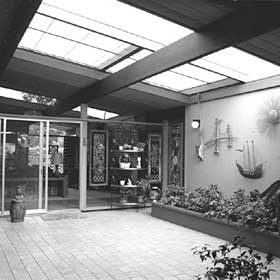Eichler Atrium Covers - Page 3
 There are many design options and choices to be considered; particular ones met some of our goals easily and others less perfectly. This is essentially the key issue for anyone who considers covering their atrium: what primary goals can be met, and can trade-offs associated with less-important goals be reduced to an acceptable level.
There are many design options and choices to be considered; particular ones met some of our goals easily and others less perfectly. This is essentially the key issue for anyone who considers covering their atrium: what primary goals can be met, and can trade-offs associated with less-important goals be reduced to an acceptable level.
For us, protection from the rain and sun was key, allowing us the flexibility to furnish the atrium room in a way that we could create another living space, be it a playroom, a meditation room, or simply a foyer. However, to meet this goal alone, all one would need to do is extend the roof to cover the opening. But that brings us to our next goal, which is to preserve the light and openness that the atrium brings to the interior of our Eichler. With this consideration, we knew we needed to cover the atrium with a translucent material that protected the room from only some aspects of the sun—not the light, just the heat. How do you let maximum light in while keeping the heat out?
On the other hand, we also wanted to use the room for passive solar heating in the winter, without turning it into a potential oven in the summer. So, now we wanted a cover that would let the light in year round, but needed to trap the heat inside during the winter and release it during the summer. And that introduced the question of condensation, a by-product of having in-ground plants that required watering. How do you do all of this without turning your Eichler's atrium into a greenhouse?
An obvious solution, we pondered, might be to install a retractable skylight, keeping it mostly closed during the winter and partially open during the summer. But since cost was a concern, and retractable designs tended to escalate the price, the simpler and less-costly solution appeared to be a fixed structure with adequate venting that could be controlled depending on seasonal needs. The materials could solve the problems of preserving light, reducing heat gain, and insulating against heat loss.
We determined that the key ingredient in the mix was the glass, and fortunately in that area we could benefit significantly from new technology introduced over the last decade. Engdahl's new glass specialist recommended a glass product coated with microscopically thin, optically transparent layers of silver sandwiched between anti-reflective metal oxide. These "smart" coatings allowed in visible sunlight while blocking infrared and ultraviolet solar energy during summer, and reduced heat loss by reflecting room-side heat back inside during winter. Jack even had a solution to address our condensation concerns, proposing a 6x4-foot retractable vent, incorporating an electronic rain sensor, at the highest point of our sloped roof line.
Now we're down to making a final decision.
- « first
- ‹ previous
- 1
- 2
- 3




